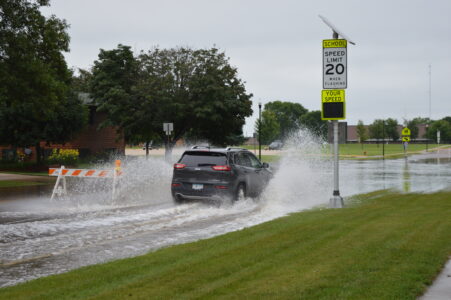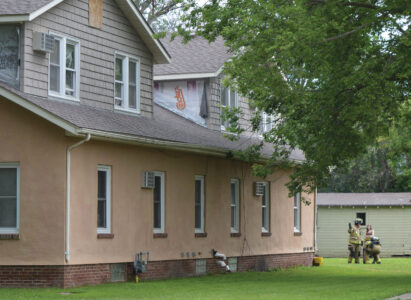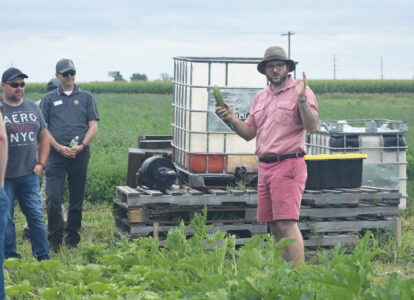Methodical Swanson search spans entire Saturday
RURAL PORTER – The sight of searchers down on their hands and knees digging through a section of dirt, looking for possible remains of a missing person is heart-wrenching, but it is oftentimes what it takes to locate evidence, or on the flip side, rule out a certain area.
Trained searchers, like the ones who volunteered to continue the search for Brandon Swanson on Saturday, are a rare find in this world. They selflessly share of their time and talents without regard for the financial burden it takes on them. Including search manager Ken Anderson of Emergency Support Services, none of the search and rescue dog units present get reimbursed for their services and travel costs. And as it turned out, all of the dog handlers were from out of state (Iowa, Illinois and South Dakota).
“We’re using very experienced canine teams,” Anderson said. “We also have support crews that have worked with us in the past, so we have people who have good training, and then also a small number of people from the general public.”
Swanson was 19 years old when he disappeared – on May 14, 2008 – on his way home to Marshall after a college graduation party in Canby. He called home to his parents at 1:54 a.m., asking them to come get him after he got his car hung up in a ditch along a gravel road. Believing he was near the town of Lynd, Swanson directed his parents, Annette and Brian Swanson, to that area.
Frustrated that his parents were unable to locate him, Brandon made a fateful decision to start walking toward what he believed was Lynd, talking on his cellphone to his dad for 47 minutes. Brandon reportedly told his dad that he was trying to save time by cutting through fields, and that he was coming across fences and hearing the sound of running water. Then suddenly, the phone call ended.
Law enforcement was alerted a few hours later, and though there were a few complications due to the way missing adult cases were still being treated back in 2008, Brandon’s car was found that afternoon near Taunton.
But there was no sign of Brandon. And despite massive searches that have yielded some clues the past seven years, there has been no concrete evidence of his whereabouts since. But that doesn’t mean people have given up or lost faith, which Brandon’s family appreciates.
“Law enforcement, they do what they’re prescribed to do, but can only take it to a certain point,” Annette Swanson said. “They focus on certain aspects of it. In difficult cases like Brandon’s, you need a two-fold approach. You need the investigative part of it and also the search and rescue part of it. You want answers. Sometimes, the answer is you’ve done everything you can. But if you haven’t, that’s the part I couldn’t live with. If there’s more to do, I wouldn’t be able to reconcile that.”
Tips have continued to come forward, but authorities say there is no evidence of foul play, nor is there any indication that Brandon attempted to stage his own disappearance. So, unfortunately, the search has shifted from a rescue to a recovery.
According to Anderson and former search manager, Jeff Hasse, the founder of Midwest Technical Rescue Training Associates, the search for Brandon Swanson has been the biggest one they’ve been involved with in terms of length of time, number of missions and amount of searchers involved. It’s estimated that well over 500 volunteers, including more than 30 dog handlers have covered more than 122 square miles.
“This is the toughest terrain there is with the exception of Canada,” Anderson said. “The distance is large and the wind is greater. That is not what you have in most searches. The area might be large, but the wind is more consistent and not like this at all. It’s constantly shifting here.”
Searchers have been unable to find the clothing, jewelry or glasses Brandon was wearing but there have been indications there are human remains in the search area. Those indications were identified through the use of multiple human remains detection (HRD) dogs. It’s important to note, however, that HRD dogs do not pick up the scent of a specific person, like a tracking or trailing canine might, but rather, they are trained to locate the odor of human death.
“We’ve been out here about every other weekend for two years,” Anderson said. “There were indications that we were previously unable to follow up (due to harvest schedules and uncooperative weather). It’s never the same here from one day to the next. (On Saturday), we focused on an area and spent quite a bit of time, not only working the area with canines, but also with other resources, down to the point where we’re down on our hands and knees sifting through surface material.”
A lot of different resources have been used and since Brandon went missing. Likewise, countless data has been compiled as searchers try to pinpoint the young man’s remains. As volunteers continue attempting to unlock the mystery, they know that time is not on their side when it comes to scent, but that the possible areas he could be in are narrowing.
“We work differently some weekends, but the search methodology is the same every weekend,” Anderson said. “You confirm (the indication of the scent of human remains) as many times as you can with qualified dogs within the same reasonable time frame so the weather doesn’t change. When the wind changes, it’s a variable.”
On every search, Anderson basically brings a mobile command center with him as well as a mobile weather station that measures temperature, humidity, wind direction, wind velocity, gust levels and pressure directions.
“We’re able to tell them what’s happening at regular intervals,” Anderson said.
Anderson noted that “nose time” is pretty limited for dogs.
“The drier that it is, the harder on their nose it is,” he said. “It also wears them out and dehydrates them more. They need to have moistness for them to function appropriately.”
Much of southwest Minnesota has been dry. Fields have been harvested and tilled, and sections of the creek being searched northwest of Porter were waist- and even shoulder-high with vegetation, making a point of detection (POD) extremely difficult.
Additional indications were identified and gathered – through amazing technology that connects canine and handler movement to GPS systems – on Saturday, though no tangible evidence was gathered.
Dedicated searchers Lois and Bill Hall brought three of their HRD dogs, all of which have the alpha system by Garmin.
“The other handlers have their own GPS, too, but it’s connected to mine,” Bill Hall said. “So we can follow their progress as well. As a team, it’s important to know where everybody went.”
The area of interest is expected to be followed up on in the near future, as weather conditions allow. Along with additional canine resources, a forensic anthropologist is expected to bring her university class of students to the search area.
“This is a commitment,” Bill Hall said. “There are so many people committed to this, which is a good thing.”



